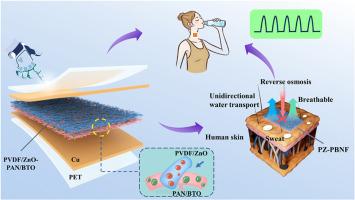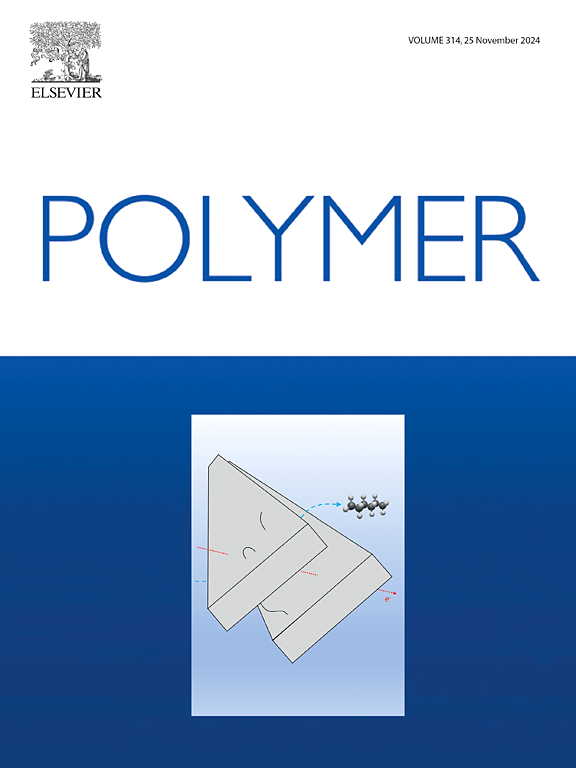用于健康传感的单向吸湿排汗 PAN/BTO-PVDF/ZnO 全纤维双层透气电子皮肤
IF 4.1
2区 化学
Q2 POLYMER SCIENCE
引用次数: 0
摘要
所有纤维电子皮肤都具有出色的柔韧性和压电特性,可广泛应用于监测和医疗保健传感领域。在应用场景中,累积的水分会影响压电信号的稳定性和灵敏度,就像剧烈出汗或潮湿的环境一样。在此,我们采用逐层电纺丝技术制造了一种双层压电传感器。内层由疏水压电聚偏二氟乙烯(PVDF)-氧化锌(ZnO)纳米纤维组成,外层由亲水压电聚丙烯腈(PAN)-钛酸钡(BTO)纳米纤维组成。基于 PVDF/ZnO-PAN/BTO 纳米纤维膜(PZ-PBNF)亲水-疏水梯度的单向排湿性能可在 1 秒内传导液体。这些纤维状 PZ-PBNF 膜还具有出色的拉伸性能(断裂伸长率为 110%)和透气性(12.065 mm/s)。这种创新的电子皮肤具有定向输水和传感功能,可确保长期佩戴的舒适性,可实际应用于新兴的可穿戴技术和各种医疗保健领域。本文章由计算机程序翻译,如有差异,请以英文原文为准。

Unidirectional Moisture-Wicking PAN/BTO-PVDF/ZnO All Fibrous Bilayer Breathable Electronic Skin for Health Sensing
All fibrous electronic skin based on excellent flexibility and piezoelectric properties could be widely applied in monitoring and healthcare sensing. The accumulative moisture during application scenarios, just as violent sweat or a damp environment, can affect the stability and sensitivity of the piezoelectric signal. Here, a bilayer piezoelectric sensor was fabricated using a layer-by-layer electrospinning technique. The inner layer is composed of hydrophobic piezoelectric polyvinylidene fluoride (PVDF)-zinc oxide (ZnO) nanofibers, while the outer layer consists of hydrophilic piezoelectric polyacrylonitrile (PAN)-barium titanate (BTO) nanofibers. The unidirectional moisture-wicking performance based on the hydrophilic-hydrophobic gradient of PVDF/ZnO-PAN/BTO nanofiber membranes (PZ-PBNF) could conduct liquid within 1 s. Incorporating inorganic ZnO and BTO nanoparticles provides a practical approach to enhancing the piezoelectric output performance (277.5 mV). These fibrous PZ-PBNF membranes also exhibit excellent stretchability properties (breaking elongation of 110%) and air permeability (12.065 mm/s). This innovative electronic skin with directional water transport and sensing functions could ensure long-term wear comfort for practical application in emerging wearable technologies and all healthcare ranges.
求助全文
通过发布文献求助,成功后即可免费获取论文全文。
去求助
来源期刊

Polymer
化学-高分子科学
CiteScore
7.90
自引率
8.70%
发文量
959
审稿时长
32 days
期刊介绍:
Polymer is an interdisciplinary journal dedicated to publishing innovative and significant advances in Polymer Physics, Chemistry and Technology. We welcome submissions on polymer hybrids, nanocomposites, characterisation and self-assembly. Polymer also publishes work on the technological application of polymers in energy and optoelectronics.
The main scope is covered but not limited to the following core areas:
Polymer Materials
Nanocomposites and hybrid nanomaterials
Polymer blends, films, fibres, networks and porous materials
Physical Characterization
Characterisation, modelling and simulation* of molecular and materials properties in bulk, solution, and thin films
Polymer Engineering
Advanced multiscale processing methods
Polymer Synthesis, Modification and Self-assembly
Including designer polymer architectures, mechanisms and kinetics, and supramolecular polymerization
Technological Applications
Polymers for energy generation and storage
Polymer membranes for separation technology
Polymers for opto- and microelectronics.
 求助内容:
求助内容: 应助结果提醒方式:
应助结果提醒方式:


